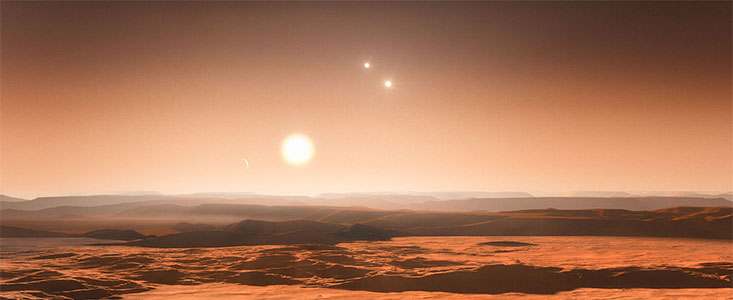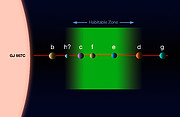Press Release
Three Planets in Habitable Zone of Nearby Star
Gliese 667C reexamined
25 June 2013
A team of astronomers has combined new observations of Gliese 667C with existing data from HARPS at ESO’s 3.6-metre telescope in Chile, to reveal a system with at least six planets. A record-breaking three of these planets are super-Earths lying in the zone around the star where liquid water could exist, making them possible candidates for the presence of life. This is the first system found with a fully packed habitable zone.
Gliese 667C is a very well-studied star. Just over one third of the mass of the Sun, it is part of a triple star system known as Gliese 667 (also referred to as GJ 667), 22 light-years away in the constellation of Scorpius (The Scorpion). This is quite close to us — within the Sun’s neighbourhood — and much closer than the star systems investigated using telescopes such as the planet-hunting Kepler space telescope.
Previous studies of Gliese 667C had found that the star hosts three planets (eso0939, eso1214) with one of them in the habitable zone. Now, a team of astronomers led by Guillem Anglada-Escudé of the University of Göttingen, Germany and Mikko Tuomi of the University of Hertfordshire, UK, has reexamined the system. They have added new HARPS observations, along with data from ESO's Very Large Telescope, the W.M. Keck Observatory and the Magellan Telescopes, to the already existing picture [1]. The team has found evidence for up to seven planets around the star [2].
These planets orbit the third fainter star of a triple star system. Viewed from one of these newly found planets the two other suns would look like a pair of very bright stars visible in the daytime and at night they would provide as much illumination as the full Moon. The new planets completely fill up the habitable zone of Gliese 667C, as there are no more stable orbits in which a planet could exist at the right distance to it.
“We knew that the star had three planets from previous studies, so we wanted to see whether there were any more,” says Tuomi. “By adding some new observations and revisiting existing data we were able to confirm these three and confidently reveal several more. Finding three low-mass planets in the star’s habitable zone is very exciting!”
Three of these planets are confirmed to be super-Earths — planets more massive than Earth, but less massive than planets like Uranus or Neptune — that are within their star’s habitable zone, a thin shell around a star in which water may be present in liquid form if conditions are right. This is the first time that three such planets have been spotted orbiting in this zone in the same system [3].
“The number of potentially habitable planets in our galaxy is much greater if we can expect to find several of them around each low-mass star — instead of looking at ten stars to look for a single potentially habitable planet, we now know we can look at just one star and find several of them,” adds co-author Rory Barnes (University of Washington, USA).
Compact systems around Sun-like stars have been found to be abundant in the Milky Way. Around such stars, planets orbiting close to the parent star are very hot and are unlikely to be habitable. But this is not true for cooler and dimmer stars such as Gliese 667C. In this case the habitable zone lies entirely within an orbit the size of Mercury's, much closer in than for our Sun. The Gliese 667C system is the first example of a system where such a low-mass star is seen to host several potentially rocky planets in the habitable zone.
The ESO scientist responsible for HARPS, Gaspare Lo Curto, remarks: “This exciting result was largely made possible by the power of HARPS and its associated software and it also underlines the value of the ESO archive. It is very good to also see several independent research groups exploiting this unique instrument and achieving the ultimate precision.”
And Anglada-Escudé concludes: “These new results highlight how valuable it can be to re-analyse data in this way and combine results from different teams on different telescopes.”
Notes
[1] The team used data from the UVES spectrograph on ESO’s Very Large Telescope in Chile (to determine the properties of the star accurately), the Carnegie Planet Finder Spectrograph (PFS) at the 6.5-metre Magellan II Telescope at the Las Campanas Observatory in Chile, the HIRES spectrograph mounted on the Keck 10-metre telescope on Mauna Kea, Hawaii as well as extensive previous data from HARPS (the High Accuracy Radial velocity Planet Searcher) at ESO’s 3.6-metre telescope in Chile (gathered through the M dwarf programme led by X. Bonfils and M. Mayor 2003–2010 described here).
[2] The team looked at radial velocity data of Gliese 667C, a method often used to hunt for exoplanets. They performed a robust Bayesian statistical analysis to spot the signals of the planets. The first five signals are very confident, while the sixth is tentative, and seventh more tentative still. This system consists of three habitable-zone super-Earths, two hot planets further in, and two cooler planets further out. The planets in the habitable zone and those closer to the star are expected to always have the same side facing the star, so that their day and year will be the same lengths, with one side in perpetual sunshine and the other always night.
[3] In the Solar System Venus orbits close to the inner edge of the habitable zone and Mars close to the outer edge. The precise extent of the habitable zone depends on many factors.
More information
This research was presented in a paper entitled “A dynamically-packed planetary system around GJ 667C with three super-Earths in its habitable zone”, to appear in the journal Astronomy & Astrophysics.
The team is composed of G. Anglada-Escudé (University of Göttingen, Germany), M. Tuomi (University of Hertfordshire, UK), E. Gerlach (Technical University of Dresden, Germany), R. Barnes (University of Washington, USA), R. Heller (Leibniz Institute for Astrophysics, Potsdam, Germany), J. S. Jenkins (Universidad de Chile, Chile), S. Wende (University of Göttingen, Germany), S. S. Vogt (University of California, Santa Cruz, USA), R. P. Butler (Carnegie Institution of Washington, USA), A. Reiners (University of Göttingen, Germany), and H. R. A. Jones (University of Hertfordshire, UK).
ESO is the foremost intergovernmental astronomy organisation in Europe and the world’s most productive ground-based astronomical observatory by far. It is supported by 15 countries: Austria, Belgium, Brazil, Czechia, Denmark, France, Finland, Germany, Italy, the Netherlands, Portugal, Spain, Sweden, Switzerland and the United Kingdom. ESO carries out an ambitious programme focused on the design, construction and operation of powerful ground-based observing facilities enabling astronomers to make important scientific discoveries. ESO also plays a leading role in promoting and organising cooperation in astronomical research. ESO operates three unique world-class observing sites in Chile: La Silla, Paranal and Chajnantor. At Paranal, ESO operates the Very Large Telescope, the world’s most advanced visible-light astronomical observatory and two survey telescopes. VISTA works in the infrared and is the world’s largest survey telescope and the VLT Survey Telescope is the largest telescope designed to exclusively survey the skies in visible light. ESO is the European partner of a revolutionary astronomical telescope ALMA, the largest astronomical project in existence. ESO is currently planning the 39-metre European Extremely Large optical/near-infrared Telescope, the E-ELT, which will become “the world’s biggest eye on the sky”.
Links
- Research paper
- Description of HARPS
- Photos of the La Silla Observatory
- eso1214 — press release describing earlier observations of Gliese 667C by the HARPS team
- eso0939 — press release describing original observations of this star using HARPS
- Keck Observatory
- Las Campanas — Magellan telescopes
Contacts
Guillem Anglada-Escudé
Institut fur Astrophysik, University of Göttingen
Göttingen, Germany
Tel: +49 0551 39 9988
Email: guillem.anglada@gmail.com
Mikko Tuomi
Center for Astrophysics Reseach, Hertfordshire University
Hatfield, UK
Tel: +44 01707 284095
Email: miptuom@utu.fi
Rory Barnes
Department of Astronomy, University of Washington
Seattle, USA
Tel: +1 206 543 8979
Email: rory@astro.washington.edu
Richard Hook
ESO education and Public Outreach Department
Garching bei München, Germany
Tel: +49 89 3200 6655
Cell: +49 151 1537 3591
Email: rhook@eso.org
About the Release
| Release No.: | eso1328 |
| Name: | Gliese 667C |
| Type: | Milky Way : Star : Circumstellar Material : Planetary System |
| Facility: | ESO 3.6-metre telescope, Very Large Telescope |
| Instruments: | HARPS, UVES |
| Science data: | 2013A&A...556A.126A |







